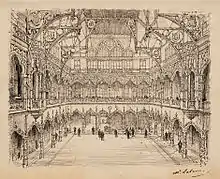Bourse of Antwerp
The bourse of Antwerp was the world's first purpose-built commodity exchange (it was founded before stocks and shares existed, so was not strictly a stock exchange).[1] Falling into disuse in the 17th century, from 1872 until 1997 the restored building housed the Antwerp Stock Exchange. After further restoration, the building is now part of an events venue that goes by the English name Antwerp Trade Fair. The Royal Exchange, London was modelled on the Antwerp Exchange.[2]

History
As Antwerp took over the role of trade center from Bruges, it grew into a large metropolis with more than 100,000 inhabitants, including 10,000 foreign merchants, mostly Spaniards and Portuguese. From 1531 the old bourse was given a new building, conceived as a rectangular square with galleries covered on four sides, built on top of a street intersection. For half a century this exchange would be the focal point of European trade and the model for cities with similar ambitions.
On the initiative of Thomas Gresham, the representative of the English crown in Antwerp, the Royal Exchange, London was opened in 1565 on this model. It was also called "the Bourse" until Queen Elizabeth I, after a visit on January 23, 1570, changed its name to the Royal Exchange.[3] The Middelburg stock exchange was opened in 1592, then Rotterdam in 1595 and Amsterdam in 1611.
Building
The first building in Brabant's late Gothic style dates from 1531, after a design by Domien de Waghemakere. A rectangular open space was enclosed by a colonnade covered with star and net vaults.[4] The gallery concept of this building served as a model for London's Royal Exchange (designed by Hendrik van Paesschen), as well as for Rotterdam, Amsterdam and Lille.[5] The high-rise 'pagoda towers' with octagonal and cylindrical hull may have served as a lookout for the harbor. Every nation had a more or less permanent location at the exchange.[6]
After a fire in 1583, the Bourse was immediately rebuilt to the same plan. The Siege of Antwerp (1584-1585) and the surrender to the 'Spanish' Army of Flanders led to a decline in trade, with Antwerp unable to compete with Amsterdam. Between 1661 and 1810 the building was used, among other things, as a drawing academy and seat of the Guild of Saint Luke.[7] The open interior space was domed in 1853 by Charles Marcellis, following the example of London's Crystal Palace.
After a second fire in 1858 had once again destroyed the building, the Antwerp city authorities twice organized a design competition in which the old concept had to be preserved. The current building was finally completed in 1872 by architect Joseph Schadde. It is a remarkable combination of the neo-gothic style and revolutionary techniques, in particular the metal construction for the covering of the interior. The building housed the Antwerp Stock Exchange (a true stock exchange) from 1872 until its 1997 merger with the Brussels Stock Exchange.[7]
With the closure of the Antwerp Stock Exchange in 1997, the building lost its function and was abandoned and neglected.[8] After a long and intensive renovation, it was to have reopened in October 2019 as an event hall with restaurant, hotel and public passage.[9] Reopening is currently scheduled for "early" 2020.[10]
References
- "Antwerp Bourse--World's Oldest--Closes". Los Angeles Times. 1997-12-31. ISSN 0458-3035. Retrieved 2019-03-22.
- "Royal Exchange, London". www.walklondon.com. Retrieved 2019-03-22.
- British-history.ac.uk: Old and New London: Chapter XLII, The Royal Exchange (Walter Thornbury, 1878)
- J. Denucé, "De Beurs van Antwerpen, oorsprong en eerste ontwikkeling, 15e en 16e eeuwen", Antwerpsch Archievenblad. Antwerpen, Dienst der Stadsarchieven, 1931, pp. 80-145.
- Sonja Anna Meseure (1987), Die Architektur der Antwerpener Börse und der europäische Börsenbau im 19. Jahrhundert, Scaneg, München
- Joey De Keyser (2007), De visie van vreemdelingen op de Zuidelijke Nederlanden in de late middeleeuwen en de renaissance, Masterproef Universiteit Gent
- Fiche Handelsbeurs (ID: 6243); Inventaris van het Bouwkundig Erfgoed. Consulted 28 Feb. 2014.
- Handelsbeurs lijdt onder extreme verwaarlozing, Gazet van Antwerpen, 10 June 2011.
- Antwerpen moest vijftien jaar wachten, maar daar is de Handelsbeurs weer in volle glorie, Gazet van Antwerpen, 4 October 2019
- "New Exchange Handelsbeurs". Visit Antwerp. 2020.